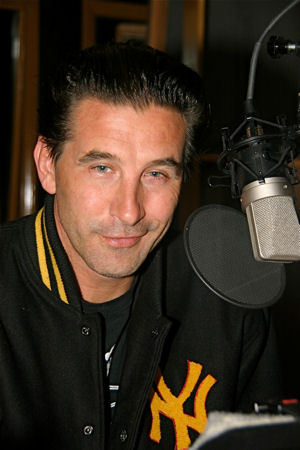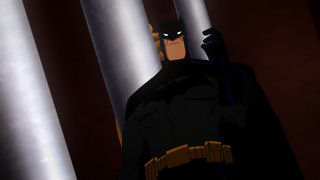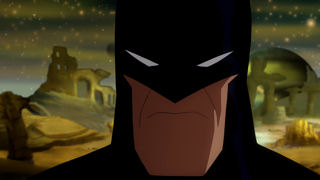|
William
Baldwin Finally Dons The Cowl
Voicing Batman In Justice League: Crisis
On Two Earths
| |
| "I
was very excited to do this." |
Dirty Sexy Money star William Baldwin slides easily into
the famed cowl as the voice of Batman in Justice League: Crisis
on Two Earths, an all-new DC Universe Animated Original PG-13
Movie from Warner Premiere, DC Comics and Warner Bros. Animation.
A
fan of the super hero genre since his youth when the Baldwin
brothers would role play in their backyard, William Baldwin
has proudly, enthusiastically undertaken the deep, gravelly
vocal tones of the Dark Knight. While Baldwin has crafted
a fine career in live-action film and television, Justice
League: Crisis on Two Earths represents only his second
foray into voiceover for animation, having recorded a few
episodes on the Nickelodeon series Danny Phantom.
Beyond
ABC’s Dirty Sexy Money television series, Baldwin
has offered memorable turns in the feature films Forgetting
Sarah Marshall, Flatliners, Backdraft and The Squid and
the Whale, the latter of which earned (ironically) a Gotham
Award for Best Ensemble Cast.
Justice
League: Crisis on Two Earths is an original story from award-winning
animation/comics writer Dwayne McDuffie (Justice League).
Bruce Timm (Superman Doomsday) is executive producer, and
the film is co-directed by Lauren Montgomery (Green Lantern:
First Flight) and Sam Liu (Superman/Batman: Public Enemies).
The full-length animated film will be distributed by Warner
Home Video on February 23, 2010 as a Special Edition 2-disc
version on DVD and Blu-Ray™ Hi-Def, as well as single
disc DVD, and On Demand and Download.
Baldwin
took time after his recording session to chat about visualization
techniques in the sound booth, his children’s influence
on his choice of roles, the super hero roughhouse role play
by the Baldwin brothers (particularly Alec Baldwin) in their
youth, and his very nearly being cast in the live-action
role of Batman. Now let the man speak …
GARY
MIEREANU: What are your thoughts about
joining the list of actors from Adam West and Michael Keaton
to Val Kilmer and George Clooney to Kevin Conroy and Christian
Bale – that have played Batman?
WILLIAM
BALDWIN: I almost did join that group – I
was one of Joel Schumacher's top choices when Val Kilmer
wound up playing Batman. Tim Burton and Michael Keaton had
left, so Joel had the luxury of replacing Michael Keaton
and he told me that his four choices – which was an
eclectic, diverse array – were Daniel Day Lewis, Ralph
Fiennes, Val Kilmer and me. I didn’t even know it
at the time – he told me when I had a meeting with
him later.
The
next time, when George Clooney did it, (Schumacher) said,
“You were on my original short list with those other
three actors, but the studio went with Val and this time
I'd like to go with you.” And that Friday afternoon,
I thought I was playing Batman – and then Monday morning,
the headlines in the trades said that George Clooney had
gotten the part. So apparently, I did actually come very
close.
I was very excited to do this. I wasn't
really thinking about any past Batmans, but more of letting
the material sort of dictate the choices that I make as
an actor. What's happening physically, what's happening
emotionally, what's happening in the writing. That’s
what really drives your performance.
GARY MIEREANU: How did you
choose to interpret the character? And was there anything
you wanted to do differently than what had preceded you?
WILLIAM
BALDWIN: I was mostly influenced by whom I perceive
Batman to be, with the possible exception that I think sometimes
I allow a certain sensitivity or an emotional dynamic to
give (the character) maybe a likeability or an accessibility.
That's almost an insecurity of mine as an actor –
to want to breathe a little bit of those types of emotions
into characters. I think I find them more appealing and
more likeable and more human.
What
I didn't choose to do is to go towards the darkness of the
way the original Batman series was intended. Because Batman,
in the original comic series, was a lot darker than the
character that was brought to life in television.
GARY
MIEREANU: Are there any personal attachments
to Batman that make voicing this role special for you?
| |
| "...we
were having wicked, twisted fun with it." |
WILLIAM
BALDWIN: It’s a number of things –
certainly the history of the character. The people that
have been lucky enough to portray Batman on screen, or provide
his voice, is a short list and it's pretty cool. I'm in
good company.
I enjoyed
it as a child, and the character still resonates for me.
And I'm a father of an 8-year-old, a 7-year-old, and a 4-year-old
– my boy is sandwiched between his sisters, and he
just loves the super heroes. We watch Justice League together.
I try not to let him overdo it too much with television,
but there's great, wholesome messages that come out of that
series. When I told him that I was playing Batman, his jaw
dropped. I almost took him out of school today to have him
come down here (for the recording session).
GARY
MIEREANU: How many times have you said
“I'm Batman” in the past week?
WILLIAM
BALDWIN: Probably about a half a dozen, usually
just joking with my kids and my wife. I was in the studio
about a 9-iron from here, where my wife (Chynna Phillips)
was recording, and all the band members were giving me different
lines to say as Batman. Or having me improvise some lines.
And we were having some wicked, twisted fun with it (he
laughs).
GARY
MIEREANU: It seemed you were quite focused
in the booth, conveying all the physical and emotional traits
as Batman. How immersed in the role did you feel?
WILLIAM
BALDWIN: I take it seriously. And I enjoy it, especially
recreating the sound effects of the fight sequences and
stuff like that. One thing that was interesting to me was
how clean they need the lines and, thus, how specific I
had to keep my relationship to the microphone, and making
sure there weren't any other sort of ancillary sounds.
When
I'm doing looping for a film, I guess it's sort of a method
approach. I'll put things inside my mouth and try to recreate
the circumstances or the emotions that existed while I was
performing. There's nothing better than when you're grunting
from lifting something to try and create that sensation.
I do a lot of visualization, too.
So when
you’re having the confrontation with Lex Luthor or
Superwoman, sometimes I'll look through the mike into the
booth to somebody in the room. I'll look at them and just
sort of imagine it in my mind, to just pick somebody and
lock into that, giving off this energy to them. It's very
helpful for me to have that specificity to lock into.
GARY
MIEREANU: Did the Baldwin brothers play
super hero games growing up?
WILLIAM
BALDWIN: You’ll have to get my brother Alec
in here sometime – he's got the scars to prove it.
Back in the early ‘60s, he tied a bathroom towel around
his neck as a cape and was doing his Superman (impression),
and he went through a plate glass sliding door. He ran right
through it. He has these big V-shaped scars under his bicep
and his forearm from all the stitches that he took when
he was five or six years old.
So yeah, we did play super hero games. And
my family was pretty rough. I mean, when we were playing
super heroes, if there was a cartoon where somebody got
thrown off the roof and they landed on the ground with a
thud, then Stephen or I got thrown off the roof –
into a pile of leaves, or into somebody's swimming pool.
GARY
MIEREANU: You rode along with the Chicago
Fire Department to prepare for Backdraft. What kind of research
went into this performance?
| |
| "Batman's
spectrum of emotion is fairly narrow -- for a number
of reasons." |
WILLIAM
BALDWIN: First of all, some parts lend them self
to that type of research and preparation more than others.
Secondly, I had a fairly deep understanding of this character
because I've been watching the shows and films and the character
for 40 years. So if I felt like I didn't have enough of
an understanding, I probably would have postponed (the
recording session).
But
when I was looking at the script on a plane a few days ago,
I felt it was kind of a piece of cake based on my understanding
of the character, and really fueled my attraction to the
character and the piece. There's a lot of two- and three-line
exchanges rather than two- and three-paragraph exchanges.
There weren't a lot of monologues that required a lot of
line memorization, or anything incredibly challenging emotionally.
I just had to get into the rhythm of how the character speaks.
Batman’s
spectrum of emotion is fairly narrow – for a number
of reasons. He's always in command, he's always in control,
he's always holding it together, and he's pretty tough relative
to the rest of us in this room.
GARY
MIEREANU: Does the Gotham City/New York
connection hold anything special for a lifelong New Yorker?
WILLIAM
BALDWIN: There's always been something cool about
(Gotham City) being based on New York – it’s
where I'm from, where I grew up, and I’ve spent my
whole career there. I remember referring to it as Gotham
– not Gotham City, either – more often than
I called it Manhattan or New York. I'd be on the West Coast
finishing a meeting, and somebody would ask, “Where
you going?” And I’d always say “Back to
Gotham.”
GARY
MIEREANU: Did having children that enjoy
the genre influence your desire to give voice to an animated
character at this point in your career?
WILLIAM
BALDWIN: That definitely motivates a lot of the
choices that I make as an actor now. I'm looking to be involved
with projects that are family oriented. Not exclusively,
but I'd like to do some things that my children can see.
My brother Alec has done a series of films over the last
couple years – Madagascar and Thomas
(the Tank Engine) and things like that –
and the kids got really, really excited about that. And
we're good friends with Chazz Palminteri, and Chazz does
a lot of animated voiceover work. When they hear his voice,
they really get excited.
I was
doing a television series for two seasons, so we would watch
that together as a family. Sometimes I would let the kids
stay up, and they really got a kick out of it. I did a film
last year with Henry Winkler called A Plumm Summer
that won a couple of family film festival audience awards.
So yes,
I'm definitely looking for some choices. Because the films
in my past, like Flatliners and Internal Affairs,
Three Of Hearts and Backdraft and Sliver,
Fair Game and The Squid And The Whale and
Forgetting Sarah Marshall, these are all films
that my kids aren't quite ready to see.
GARY
MIEREANU: You've tackled this legendary
comic character. What other roles would you like to fill?
WILLIAM
BALDWIN: I'd like to surprise some people maybe
and do the voice of something that's much more charactery.
It could be much more ethnic. Jewish or Irish or a New Yorker.
I have a lot of fun with that stuff. I'd even like to sing.
I wouldn't want to sing in the way that you would need Mariah
Carey to sing, but just have a character sing and have fun
with that, too.
GARY
MIEREANU: What were your impressions
of this animation experience versus some of your previous
experiences?
WILLIAM
BALDWIN: I'm getting better at it. I'm very tough
on myself, so I'm never quick to say that I felt like it
was great when it wasn't. I usually have my own sort of
standards that I set for myself. It felt like I was able
to achieve my objectives more quickly. I think that comes
with maturity as a performer and, uh, it's nice to know.
Because there's been times where I've done voiceover work
where they would normally allot two hours for someone who
can bang it out, and they would have to allot three or three
and a half or four hours.
It’s
not that I couldn't do it quickly, it's just that I'm such
a perfectionist. I tend to be saying “Let me try that
again. Let's do one more … one more … one more.”
I think I said, “Let me do one more” about 10
times today, which wasn't a lot. Sometimes I say it 100
times. I think everybody thought that it felt right, it
felt good, it sounded great. It’s always fun, but
I want to get it right.
GARY
MIEREANU: Is it difficult acting alone
in the booth?
WILLIAM
BALDWIN: It forces you to hone in and focus on
the performance aspects and the emotional aspects of what
you're trying, and visual them in your head. Acting is not
acting, it's reacting. You're reacting to what somebody's
saying and how they're saying it.
That
was great about the television show that I just did (Dirty
Sexy Money) because the props department would tie
me in when we would do something like a telephone conversation.
When I had one with Donald Sutherland, I didn't have to
come into the studio to do it. They would just have me call
on my cell phone from my home in Santa Barbara, and I would
call in when the camera was rolling and I would literally
have the conversation with him.
| |
| "Give
me a little bit more urgency." |
In the
old days, sometimes you would have the other actor come
in on his off day just to read that telephone conversation
off camera. Then that changed and you would wind up reading
this telephone conversation with the script supervisor who
(A) is not an actor, and (B) does not know what the choices
of the actor are going to be when they shoot his side of
the telephone conversation in two weeks.
That
can be very difficult and very stilted when they cut that
telephone conversation together – sometimes you can
tell by the way someone's reacting to a line that they weren't
hearing the actor do it on that day. They just interpreted
what they thought the actor was going to do on that day,
and they were wrong. I'm talking about stuff that's very
subtle, like someone raising their voice a little bit in
the reaction to the other person. Little things.
But
that’s acting. You’re not just reacting to the
words, you're reacting to the way the words were said. Was
it threatening? Was it menacing? Was it intimidating? Was
it submissive? It's all based on little layers and subtleties.
GARY
MIEREANU: Can you compare acting on camera
to acting in the booth, and how Andrea Romano was able to
guide you through those differences?
WILLIAM
BALDWIN: It's sort of a mixed bag. On camera, you’re
usually acting to another actor who you're looking at, who's
in the room with you. Today, I was in the sound room and
Andrea was behind the glass. And she’s not an actor.
But for a director, from a performance standpoint, she was
giving me more than enough.
What
really helped was the specificity of her notes. When something
wasn't right, she would give me a note that would 180 it,
or she would give me a little subtle note. That was great.
“You're forgetting to add in this layer” or
“Give me a little bit more urgency.”
At one
point, I throw a punch and Superwoman catches my fist and
starts to squeeze my fist. And I said, “Do you want
me to wince and scream in pain when she's crushing my fist?
And am I supposed to fight the temptation of revealing to
a woman – because wouldn't Batman wouldn't want to
give away that power that a woman is causing the pain.”
I mean, it would be different if Lex Luthor or Superman
were doing this, right? So we sort of hashed that out and
found those sort of things as we were going along.
Justice
League: Crisis on Two Earths is an original story from award-winning
animation/comics writer Dwayne McDuffie (Justice League).
Bruce Timm (Superman Doomsday) is executive producer, and
the film is co-directed by Lauren Montgomery (Green Lantern:
First Flight) and Sam Liu (Superman/Batman: Public Enemies).
The full-length animated film will be distributed by Warner
Home Video on February 23, 2010 as a Special Edition 2-disc
version on DVD and Blu-Ray™ Hi-Def, as well as single
disc DVD, and On Demand and Download.
For
more information, images and updates, please visit the film’s
official website at www.JUSTICELEAGUECRISIS.com.
|









